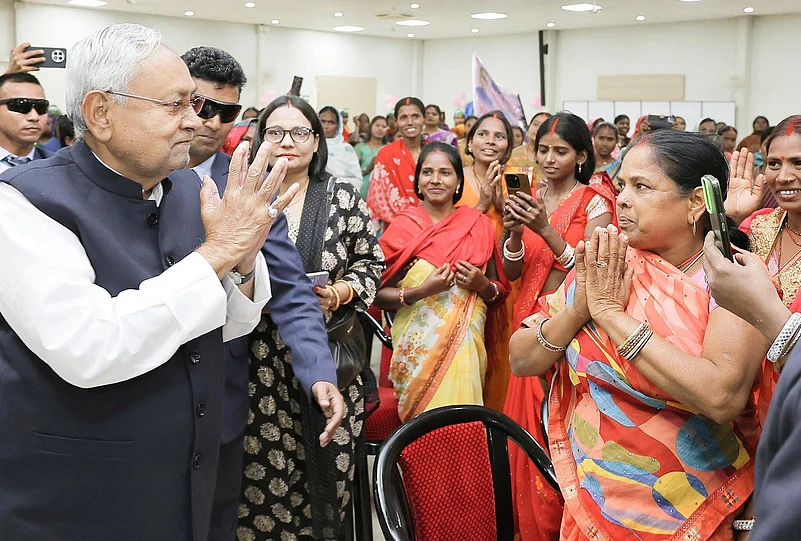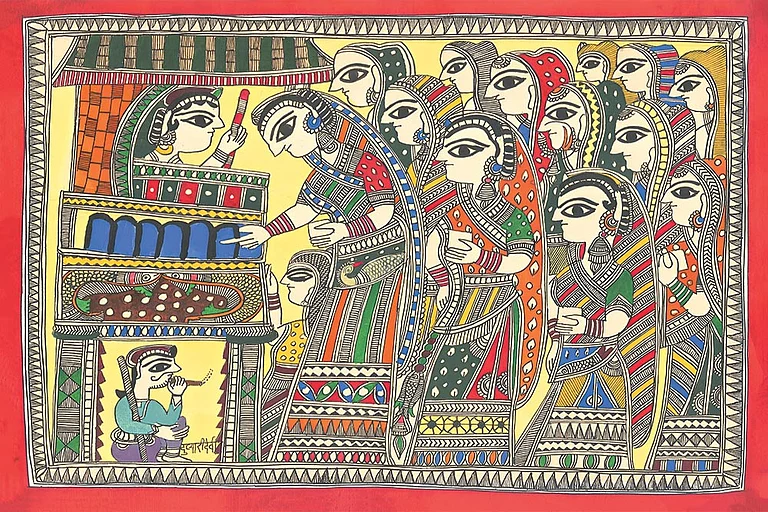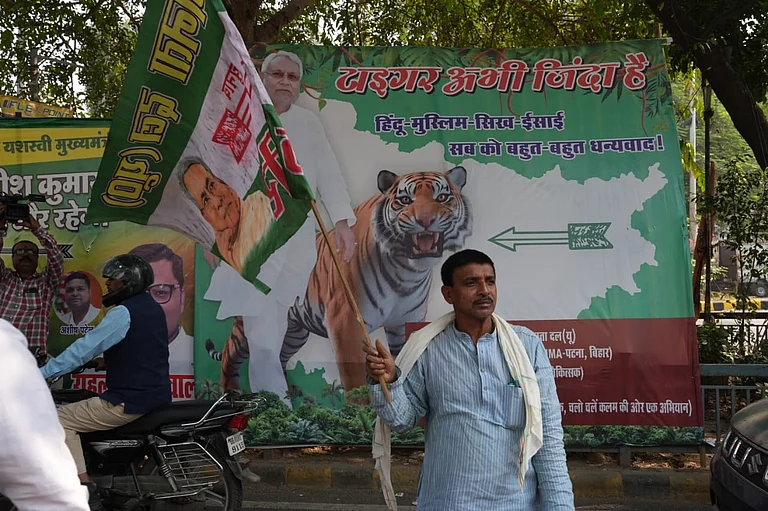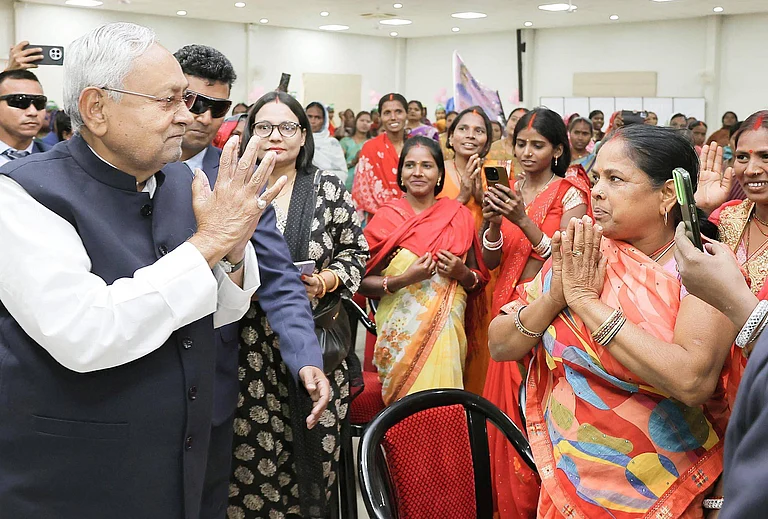
Bihar’s 2025 verdict is a historic mandate driven by unprecedented women’s voter turnout.
Nitish Kumar’s governance model has transformed feminist welfare into a durable civic architecture.
Women have emerged as the core administrators, service providers, and moral centre of the state’s political economy.
Bihar’s 2025 Assembly elections results have unfolded like a political tsunami triumphing over both the crude majoritarian arithmetic of the Mahagathabandhan and the hyped aspirational politics of Jan Suraaj. The unprecedented landslide victory of the JD(U)-BJP alliance-marking Nitish Kumar’s tenth term as Chief Minister is not simply an incumbency win. It also represents a structural repudiation of the personality-driven, dynastic and plebiscitary grammar that dominates political life in many Indian states.
What renders the 2025 mandate historic is the convergence of two decisive forces. First is the extraordinary political longevity of Nitish Kumar, who has survived ideological ruptures, coalition realignments, and persistent speculation about his health and future. Second is the unprecedented turnout of women voters—71.6 percent, surpassing men’s 62.8 percent—signalling the rise of women as the decisive electoral bloc in a deeply patriarchal political culture. While detailed demographic data will take time to emerge, the scale of the JD(U)’s sweep, dramatically improving on its 2020 performance, makes one inference unavoidable: of the nearly 1.7 crore women voters, a decisive majority seems to have endorsed Nitish Kumar and the NDA despite resonant anxieties around rojgār (employment) and palāyan (migration). This is not merely electoral support; it is a civic endorsement of an entire architecture of feminist governance.
Nitish Kumar’s victory also reveals the temperament of a statesman whose endurance rests not on charisma or demagoguery but on method, moderation, and moral restraint. He embodies the quiet art of governing coalition contradictions, something he learnt early on from the poet-Prime Minister Atal Bihari Vajpayee under whom he first matured as a national political figure. Sankarshan Thakur, his biographer, describes him as a political alchemist—a leader who survives by transmuting contradictions into workable coalitions, moral credibility, and pragmatic governance. In an era defined by spectacle and performative populism, Nitish represents a counter-grammar of authority, one that fuses conviction with calibration, movement with moderation, and rootedness with reform.
Crucially, Nitish’s politics of ‘practical socialism’ (vyavahārik samājvād) in the words of veteran journalist Santosh Singh, emerges from temperament rather than slogans. He belongs to a diminishing tradition of Indian politicians who treat power as a process, not a performance. In the Weberian sense, he embodies the ethic of responsibility, grounded in caution, negotiation, and awareness of consequence. Max Weber’s distinction between the ethic of conviction and the ethic of responsibility is particularly instructive here.
Nitish’s durability stems from precisely this moral pragmatism. It is this ethos that has enabled him to shape what may be called Bihar’s patriarchal-to-participatory transition, a civic infrastructure of feminist democracy rooted in his socialist mentor Karpoori Thakur’s idea of equity within equity. In this sense, Bihar’s feminist democracy offers a different development economics, one in which growth is measured not only through industrialisation or urbanisation but through the expansion of civic capacity, care infrastructure, and women’s economic citizenship.
Under his leadership, women have emerged not as beneficiaries but as architects of governance. Today, they occupy nearly 52 percent of Panchayati Raj seats, including thousands of mukhiyas. They constitute the backbone of Bihar’s public-service economy: around 90,000 ASHA workers, 112,000 Anganwadi workers, 248,000 Mid-Day Meal cooks (90 percent women), more than 261,000 women teachers, and over 25,000 women police personnel, supported by a 35 per cent reservation in police recruitment. These figures point to a deeper transformation: women have become the civic face of the state, the front line of service delivery, and the moral infrastructure of governance.
This feminised civic transformation finds its most visible expression in Jeevika (Bihar’s Rural Livelihoods Promotion Society), Bihar’s most substantive social innovation in the post-2005 period. Launched in 2006 with World Bank support, Jeevika began as part of India’s broader SHG movement. But in Bihar it evolved into something qualitatively different: the institutional core of a participatory maternal welfare state.
Its success in one of India’s poorest and historically weakest administrative regions is rooted in a rare alignment of political reconstruction, gendered social capital, and institutional autonomy. Bihar’s administrative revival after 2005 created the foundations for civic experimentation. Nitish rebuilt not only the state’s material infrastructure but also its moral proximity to citizens through women’s reservation in panchayats, bicycle schemes for schoolgirls, alcohol prohibition, and the redirection of welfare through women’s collectives.
Crucially, the Bharatiya Janata Party’s pragmatic collaboration helped consolidate a broad political consensus around widening these gender-focused interventions. The BJP treated women’s empowerment as a shared electoral asset, allowing these programmes to grow without ideological friction.
Today, Jeevika spans all 38 districts and includes over 1.4 crore women, primarily from Dalit, OBC, and EBC households. What began as thrift-and-credit has become a multi-layered civic network linking welfare delivery to local solidarities. In the absence of men—most having migrated for work—women now supplement and stabilise household incomes through their collective labour.
They manage community funds, oversee nutrition drives, monitor MGNREGA, support agricultural extension, and act as social auditors. Many also run microenterprises in dairy, poultry, tailoring, mushroom cultivation, and food processing, linking village economies to regional markets. Studies indicate strong loan repayment and a positive return on investment improving consumption, savings, and income.
As of mid-2025, the combined financial footprint of Jeevika SHGs has crossed Rs. 1 lakh crore, expanding grassroots resilience and local consumption. Against this backdrop, the criticism of the Mukhyamantri Mahila Rozgar Yojana’s Rs 10,000 transfer to Jeevika didis as a freebie or voter bribe not only resulted in an electoral disaster for opposition parties but also revealed how profoundly mainstream economists misunderstand Bihar’s civic economy.
The 2025 Bihar thus is not simply a conventional victory but a social referendum. Nitish Kumar’s achievement lies not only in winning elections but in altering the moral demography of the electorate. In doing so, he has crafted one of India’s quietest yet most transformative political experiments: a feminist democracy rooted in civic agency, ethical restraint, and the everyday labour of women who now hold up the state.
(Ashwani Kumar is a poet, political scientist and the author of Community Warriors: State, Peasants and Caste Armies in Bihar.(Views expressed are personal)




























